Module 57 - CV T160
CV T160: Connected Vehicle Certification Testing Introduction
HTML of the Student Supplement
(Note: This document has been converted from the Student Supplement to 508-compliant HTML. The formatting has been adjusted for 508 compliance, but all the original text content is included, plus additional text descriptions for the images, photos and/or diagrams have been provided below.)
CV T160: Connected Vehicle Certification Testing Introduction
Table of Contents
Module Description - 2
Introduction/Purpose - 2
Samples/Examples - 2
Reference to Other Standards - 4
Case Study - 4
Glossary - 12
References - 12
Study Questions - 13
Icon Guide - 14
1. Module Description
The CV T160 module follows related modules I261/CV-261: V2I (Vehicle-to-Infrastructure) Standards for Project Managers and I262/CV262: V2V (Vehicle-to-Vehicle) ITS Standards for Project Managers. V2I refers to Vehicle to Infrastructure applications, such as broadcasting the traffic signal phase and timing countdowns as well as lane placement to approaching vehicles for red light violation warning. V2V refers to Vehicle to Vehicle applications, such as broadcasting vehicle location, heading, speed, and elevation to one another for crash avoidance. While I261 and I262 describe the standards required for vehicle and roadside equipment interoperability throughout North America, CV T160 focuses upon Certification Testing to the conformance of the connected vehicle hardware and software to the published standards.
2. Introduction/Purpose
The connected vehicle environment has the potential to transform surface transportation systems such that vehicular crashes are significantly reduced, operators of the surface transportation systems have access to more accurate system performance data, and travelers have access to specific traveler information, and allow the surface transportation systems to be optimized to minimize environmental impacts.
This module begins with an introduction to the certification testing process of Roadside Unit (RSU) and On-Board Unit (OBU) devices to ensure that communications between vehicles and roadside equipment is private, secure, and interoperable throughout North America. It is essential that agencies use standards certification tests in deploying connected vehicle technologies to maximize the benefits from the connected vehicle environment. By taking this module, participants will learn how to specify certification requirements in contract terms and conditions. Deploying certified Connected Vehicle equipment will support interoperability, minimize future integration costs, make procurements easier, and facilitate regional and national integration
This module continues to cover the privacy and security measures taken in the connected vehicle architecture to insure authenticity of the data exchanges and to insure that no personal identification information is included in the data transmitted.
3. Samples/Examples
3.1. Why is certification important?
For the first time, vehicle active safety systems must rely on data received from other vehicles and the roadside equipment, instead of only data from the vehicle itself. Traditional Traffic Management and Control are shown in the shaded area of Figure 1:
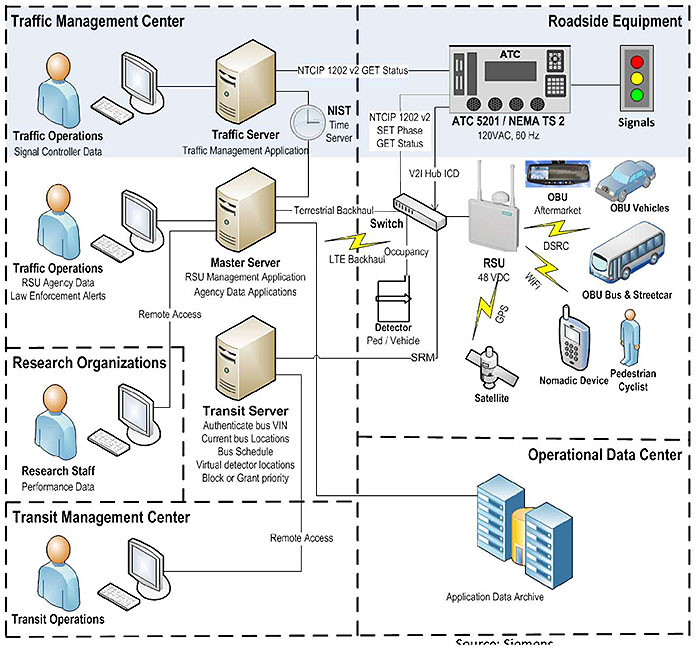
(Extended Text Description: Author's relevant description: This figure has a traffic operator in front of a screen at the upper left connected to a traffic server. The traffic server is connected to an ATC and Time Server. The ATC is connected to a network switch that is also connected to and RSU to the right and to a Master Server to the left. A flat panel display attended by a traffic management operator is also connected to the Master Server. Additionally, this figure shows an RSU with lightning bolts to Satellite, OBU class 2 and OBU class 2 at the right. A transit bus is shown to the right of the OBU class 2, as well as an OBU class 3 and pedestrian / cyclist show with a lightning bolt for WiFi to the RSU. This figure also shows connections to Traffic Operations to the Master Server, and Research Organizations with Research Staff and Performance Data, Operational Data Center with the Application Data Archive, and back to the Transit Operations at the Transit Management Center. Key Message: Backhaul Communications can include: NTCIP communications from Traffic Signal Controller to Traffic Management Center (TMC), Management of RSU by central RSU management software system, Data TO and FROM RSU to data center, Backhaul Communications is not required to implement CV applications: Vehicle to Infrastructure (V2I) messages do not require backhaul communications, such as Curve Speed Warning (CSW) and others, Security certificates can be loaded during RSU manufacture and reloaded at normal maintenance, Backhaul Communications media can vary: Ethernet Fiber Cellular.)
Figure 1: Importance of Certification, Interdependent Data Flows
3.2. Test and Certification Levels
Testing and certification occurs at Levels as shown in Figure 2:
Level 1: Procurement of software objects and hardware objects
Level 2: Test of software modules and hardware units
Level 3: Integration test of software modules installed into hardware objects to form subsystems
Level 4: Acceptance test of system to fulfill Use Case requirements
Level 5: Validation of system installed in roadside equipment and vehicles
Level 6: End to end system test, operation and maintenance
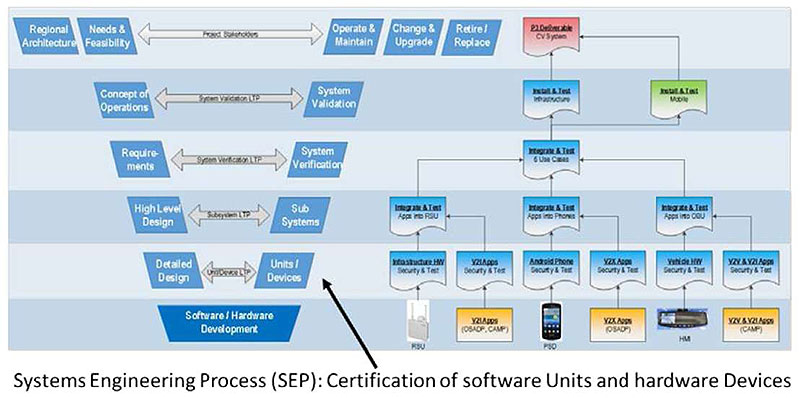
(Extended Text Description: Author's relevant description: This figure has the "VEE" model shown on the left. To the right, and corresponding to each level of the "VEE" are shown connected vehicle elements corresponding to that level of the "VEE", from bottom to top: Level 1 shows the connected vehicle hardware devices and software applications that are procured in a typical CV system. Level 2 shows a test report for hardware device test and software unit Level 2 test for each. Level 3 shows the software integration into hardware level test for each subsystem. Level 4 shows the subsystems connected and tested as a system level. Level 5 shows the system validation level test deployed with real data. Level 6 shows operations and maintenance of the deployed system to end of life.)
Figure 2: Test and Certification Levels
4. Reference to Other Standards
Connected Vehicle Wireless Stack standards compliance certifications are shown in Figure 3.
| IEEE 1609.2 | ||
| IPv6 | IPv6 | |
| 1609.3, S02.2, 802.11p | IEEE 802.2 | |
| 5.9 GHz wireless (802.11p), 1609.4 | Backhaul PHY2 | |
Figure 3: Wireless Stack Standards
5. Case Study: USDOT Connected Vehicle Pilots
USDOT funded three Connected Vehicle Pilots in which we will preview the THEA case study:
- Rural: Wyoming DOT Interstate 80 heavy truck corridor
- Suburban: Tampa Hillsborough Expressway Authority (THEA)
- Urban: New York City DOT

Figure 4: USDOT Connected Vehicle Pilots
The THEA Suburban CV pilot focuses on a "before and after" study of the effectiveness of 11 CV applications deployed as six use cases at six locations in downtown Tampa FL, with existing safety and mobility issues as shown in Figure 5.

(Extended Text Description: Author's relevant description: Example graphic of Tampa Hillsborough USDOT Pilot map and installation locations showing map of Downtown Tampa and connected vehicle pilot deployment.)
Figure 5: THEA CV Pilot Study Area and Deployments
Each of the V2I and V2V applications shown in Figure 6 are selected from the list of CV applications on the USDOT website shown in Figure 7.

(Extended Text Description: Author's relevant description: Example graphic of Tampa Hillsborough Application to Use Case and Location, showing Pilot, Category, Application, Need/Use case and Location for the THEA Pilot.)
Figure 6: Eleven CV Applications Deployed as Six Use Cases
V2I Safety
Red Light Violation Warning
Curve Speed Warning
Stop Sign Gap Assist
Spot Weather Impact Warning
Reduced Speed Work Zone Warning
Pedestrian in Signalized Crosswalk
Warning (Transit)
V2V Safety
Emergency Electronic Brake Lights (EEBL)
Forward Collision Warning (FCW)
Intersection Movement Assist (IMA)
Left Turn Assist (LTA)
Blind Spot/Lane Change Warning (BSW/'LCW)
Do Not Pass Warning (DNPW)
Vehicle Turning Right in Front of Bus Warning (Transit)
Agency Data
Probe-based Pavement Maintenance
Probe-enabled Traffic Monitoring
Vehicle Classification-based Traffic Studies
CV-enabled Turning Movement & Intersection Analysis
CV-enabled Origin-Destination Studies
Work Zone Traveler Information
Environment
Eco-Approach and Departure at Signalized Intersections
Eco-Traffic Signal Timing
Eco-Traffic Signal Priority
Connected Eco-Driving
Wireless Inductive/Resonance Charging
Eco-Lanes Management
Eco-Speed Harmonization
Eco-Cooperative Adaptive Cruise Control
Eco-Traveler Information
Eco-Ramp Metering
Low Emissions Zone Management
AFV Charging / Fueling Information
Eco-Smart Parking
Dynamic Eco-Routing (light vehicle, transit, freight)
Eco-ICM Decision Support System
Road Weather
Motorist Advisories and Warnings (MAW)
Enhanced MDSS
Vehicle Data Translator (VDT)
Weather Response Traffic Information (WxTINFO)
Mobility
Advanced Traveler Information System
Intelligent Traffic Signal System (I-SIG)
Signal Priority (transit, freight)
Mobile Accessible Pedestrian Signal System (PED-SIG)
Emergency Vehicle Preemption (PREEMPT)
Dynamic Speed Harmonization (SPD-HARM)
Queue Warning (Q-WARN)
Cooperative Adaptive Cruise Control (CACC)
Incident Scene Pre-Arrival Staging
Guidance for Emergency Responders (RESP-STG)
Incident Scene Work Zone Alerts for Drivers and Workers (INC-ZONE)
Emergency Communications and Evacuation (EVAC)
Connection Protection (T-CONNECT)
Dynamic Transit Operations (T-DISP)
Dynamic Ridesharing (D-RIDE)
Freight-Specific Dynamic Travel Planning and Performance
Drayage Optimization
Smart Roadside
Wireless Inspections
Smart Truck Parking
Figure 7: Connected Vehicle Applications
Figure 8 depicts Use Case 1: Morning Backups. Here, I-SIG and Curve Speed Warning CV applications are used to reduce ramp exit speed to within the stopping distances of the Florida Drivers Manual as the morning queue builds and reduces the safe stopping distance.
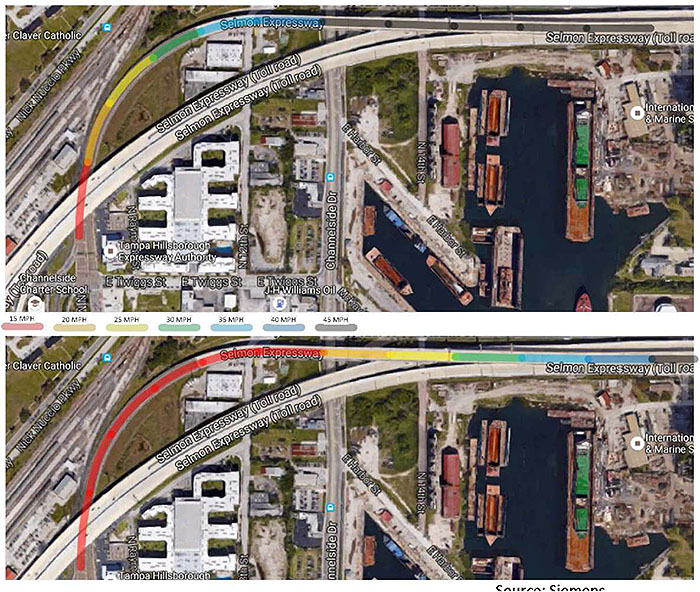
(Extended Text Description: Author's relevant description: Example graphic on top shows the End of Ramp Deceleration Warning speed zones when lightly traveled. Graphic on bottom shows the End of Ramp Deceleration Warning speed zones with a long queue at end of ramp.)
Figure 8: Use Case 1, Morning Backups using End of Lane Deceleration Warning application
Figure 9 depicts use of Wrong Way Warning when a vehicle attempts to enter the closed or inbound lanes of the Reversible Elevated Expressway (REL). The CV apps warn the violating driver before the violation occurs, warns the oncoming vehicle of a wrong-way driver, and alerts law enforcement as the violation persists.
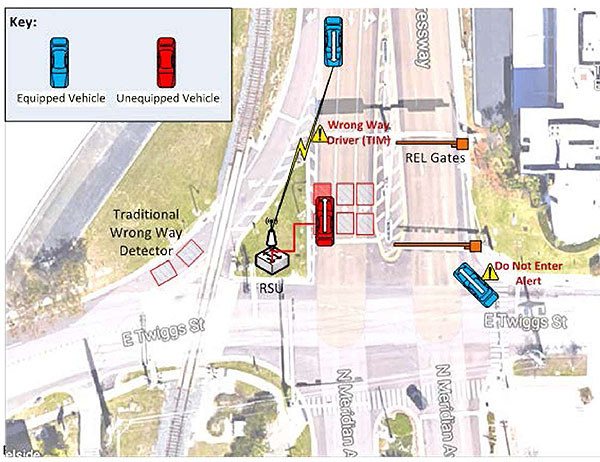
Figure 10: Use Case 2, Wrong Way Entries
Figure 10 depicts use of Forward Collision Warning and Intersection Movement Assist for pedestrian safety in an uncontrolled midblock crosswalk.

Source: HNTB
Figure 11: Use Case 3, Pedestrian Conflicts / Pedestrian Safety
Figure 11 depicts use of Connected Vehicle Transit Signal Priority (TSP) using standard CV messages compatible with the new car messages to be able to use platoons of automated and connected vehicles as transit priority.
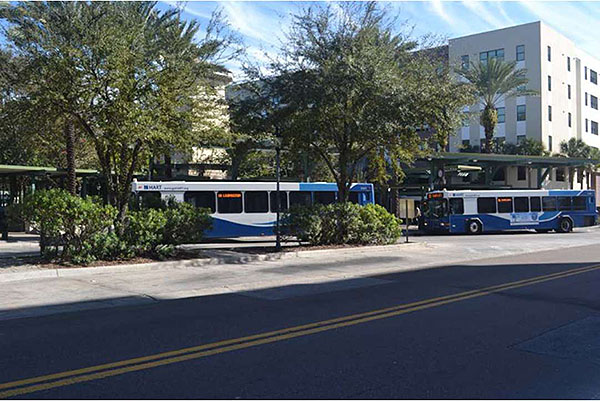
Source: HNTB
Figure 12: Use Case 4, BRT Optimization / Trip Times / Safety
Figure 12 depicts use of Connected Vehicle I-SIG application to control signals based on the arrival times and priorities of vehicles instead of timing plans.
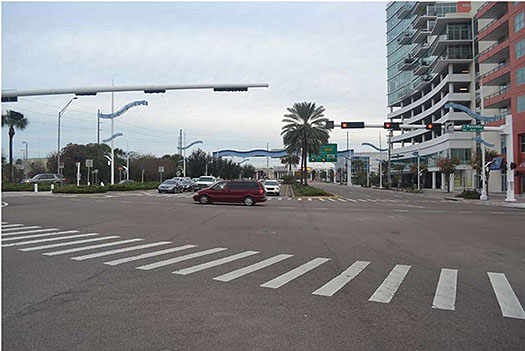
Source: HNTB
Figure 13: Use Case 5, Traffic Progression
Figure 13 depicts the aggregation of Basic Safety Messages into Vehicle Classification, speeds, and volumes without need for special roadside equipment.

(Extended Text Description: Author's relevant description: Photo of Connected Vehicle management center and screens. To the right is the following text:
The RSU also aggregates Basic Safety Messages (BSM) and sends those to the CMS.
Aggregated BSMs have the same function as conventional loop detectors and provide traffic data:
- Type of vehicle
- Speed
- Traffic volume in vehicles/hour
)
Source: Siemens
Figure 14: Use Case 6, Agency Data
6. Glossary
To include additional descriptions/acronyms used primarily in the module.
| Term | Definition |
|---|---|
| Agency Specification | A document that has been prepared by an agency to define requirements for a subject item or process when procured by the agency. |
| BSM | Basic Safety Message |
| Compliance | A condition that exists when an item meets all of the requirements of an agency specification. |
| Concept of Operations | A document that describes the purpose for a system project, including a description of the current and proposed system, as well as key user needs that the new system is required to address. |
| Conformance | A condition that exists when an item meets all of the mandatory requirements as defined by a standard. It can be measured on the standard as a whole, which means that it meets all mandatory (and applicable conditional) requirements of the standard, or on a feature level (i.e., it conforms to feature X as defined in section X.X.X), which means that it meets all mandatory (and applicable conditional) requirements of the feature. |
7. References
Connected Vehicle Pilot Deployment Program Phase 1, Concept of Operations (ConOps) - Tampa (THEA), Final Report — February, 2016 FHWA-JPO-16-311
USDOT Connected Vehicle Pilot Development Program:
https://www.its.dot.gov/pilots/
USDOT Connected Vehicle Applications:
https://www.its.dot.gov/pilots/cv pilot apps.htm
USDOT Certification Project:
https://www.its.dot.gov/presentations/plugfest 2016/Certification Overview.pdf
Connected Vehicle Pilot Deployment Program Overview:
https://www.its.dot.gov/pilots/pdf/CV PilotWebinar5 Devices QPL.pdf
Certification program for 5.9GHz DSRC:
http://omniair.org/wp-content/uploads/2016/10/2016ITSWC-TP66-7layers Dmitri-Khijniak-notes-1.pdf
USDOT Guidance for Security Operational Concept:
https://ntl.bts.gov/lib/60000/60400/60495/FHWA-JPO-16-338.pdf
Security Credential Management System Proof of Concept:
https://www.its.dot.gov/pilots/pdf/SCMS POC EE Requirements20160111 1655.pdf
USDOT Plug Fest (Secure Credential Management System (SCMS) Proof of Concept (PoC) Overview)
https://www.its.dot.gov/presentations/plugfest 2016/SCMS Plugfest.pdf
ITS Standards Training Modules: MODULE 38. I262/CV-262 Vehicle-to-Vehicle (V2V) ITS Standards for Project Managers
StandardsTraining/Modules.aspx?ModuleID=67#mod67
DSRC Roadside Unit Specifications:
http://www.fdot.gov/traffic/Doc Library/PDF/USDOT%20RSU%20Specification%204%201 Final R1. pdf
8. Study Questions
To include the quiz/poll questions and answer choices as presented in the PowerPoint slide to allow students to either follow along with the recording or refer to the quiz at a later date in the supplement.
1. What is the relationship between the RSE and RSU?
- RSE is the DSRC radio to the nearby vehicles
- RSU includes the RSE
- RSU is the DSRC radio that is part of the RSE
- Backhaul connects the RSE with the RSU
2. Which is not part of the RSU wireless stack?
- IPV6 device addresses
- Basic Safety Message (BSM) of vehicle location, heading speed, elevation
- 5.9 GHz wireless frequency band
- IEEE 1609.2 security certificates
3. Which of the following applies to Agencies requiring RSU certification process?
- Develop RSU Test Cases per each agency
- Specify independent certification test report per Certification Test Specification, with special provisions for local needs
- Purchase RSUs without contract requirements
- None of the above
4. Which of the following is not a CV application group?
- V2V Safety
- V2I Mobility
- Road and Weather
- Autopilot for self-driving vehicle
9. Icon Guide
The following icons are used throughout the module to visually indicate the corresponding learning concept listed below, and/or to highlight a specific point in the training material.
1) Background information: General knowledge that is available elsewhere and is outside the module being presented. This will be used primarily in the beginning of the slide set when reviewing information readers are expected to already know.

2) Tools/Applications: An industry-specific item a person would use to accomplish a specific task, and application of that tool to fit the need.

3) Remember: Used when referencing something already discussed in the module that is necessary to recount.

4) Refer to Student Supplement: Items or information that are further explained/detailed in the Student Supplement.

5) Example: Can be real-world (case study), hypothetical, a sample of a table, etc.

6) Checklist: Used to indicate a process that is being laid out sequentially.
